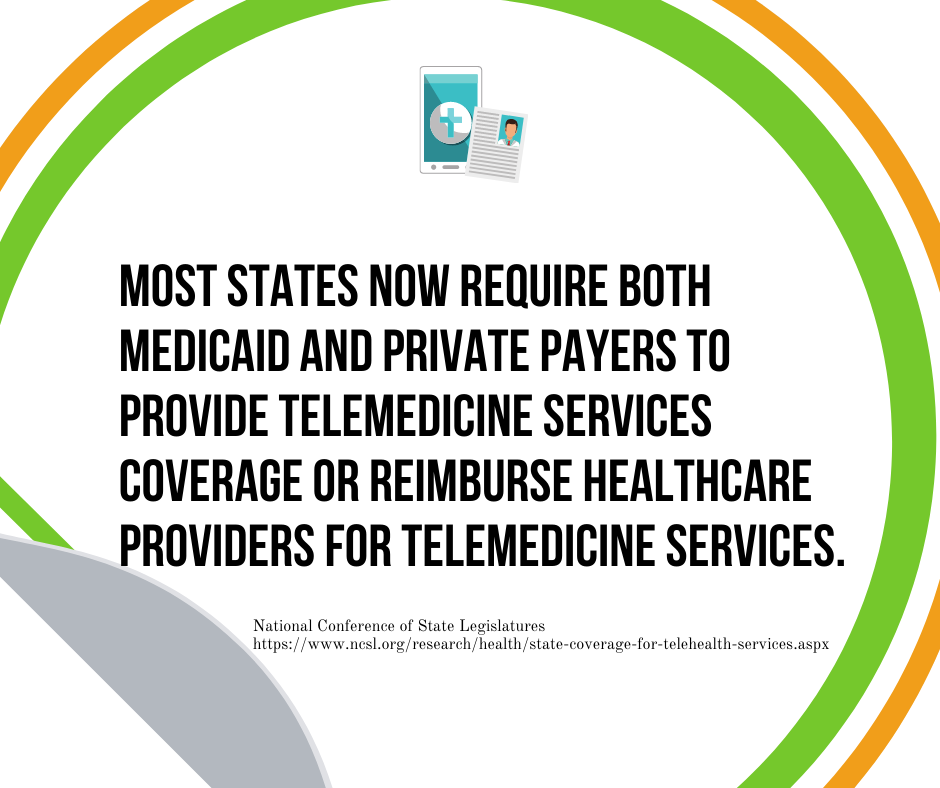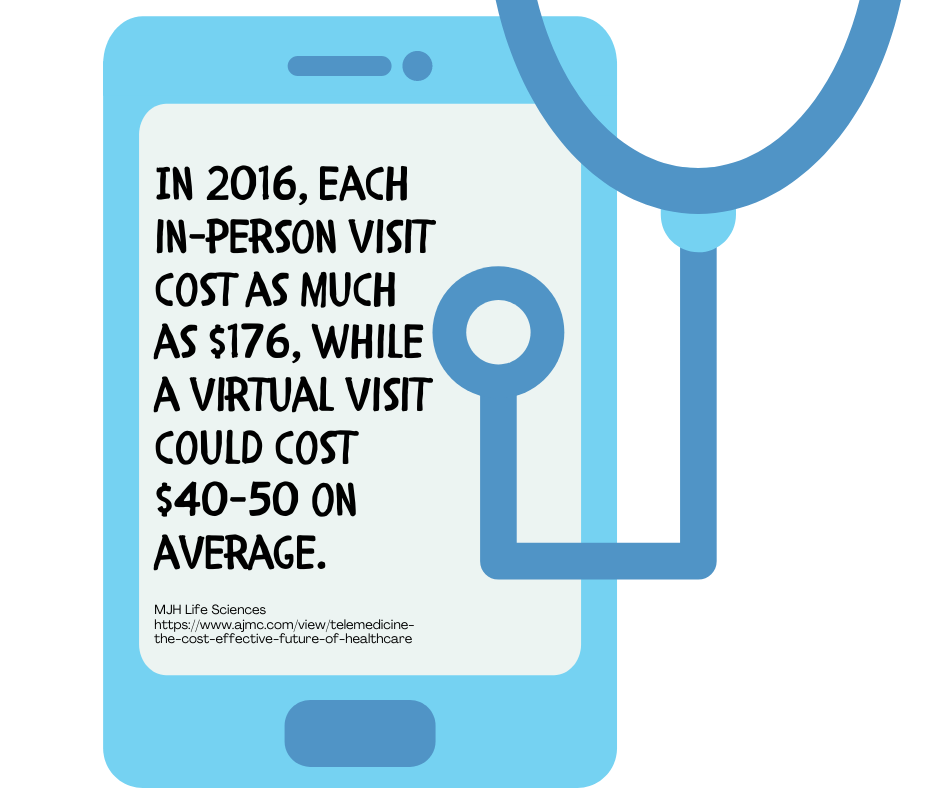Did you know that the exponential increase in the use of telemedicine and telehealth has increased due to the COVID-19 pandemic? From 13,000 to 1.7 million visits per week – and that’s only for Medicare recipients! Private insurance companies have also reported an explosive increase in telemedicine-related claims of more than 4,000% between the 2019-2020 period. Indeed, telemedicine has transitioned from being a niche novelty to a popular practice in less than a year, caused by its inherent characteristics, including physical distance, convenience, and prevention of the spread of infection.
But let’s first differentiate between telehealth and telemedicine, which are often used interchangeably but have a significant distinction. On the one hand, telehealth refers to the broad range of services and technologies used to provide patient care and ensure effective and efficient healthcare delivery. These include front-end and back-end products and services, such as patient care, clinical services, provider training, continuing medical education, and administrative functions.

On the other hand, telemedicine refers to the technologies used by physicians, nurses, and other medical professionals in providing clinical services to their patients without face-to-face, in-person visits. The technologies include hardware, software, and services, including Internet connections used for initial consultations, follow-up visits, medication management, specialist consultations, and chronic conditions management. These services are provided remotely through secure audio and video connections; patient confidentiality is still a must in telemedicine.
The distinction is important since insurance companies typically only cover telemedicine services, such as patient consultations, medications, and related hospital admissions. But it’s also important to note that insurance coverage varies between insurance companies and states, so both physicians and patients must be aware of the restrictions.
Even before the COVID-19 pandemic, telemedicine as the technology was already recognized as an up-and-coming modern convenience, albeit still somewhat of a niche novelty. We live in a mobile, consumer-driven society, and, as such, we want to avail of healthcare services when it’s convenient to us instead of when it’s convenient for physicians and other healthcare providers.
A National Business Group on Health survey reveals that the number of large employers that offered telemedicine services for their employees increased from 14% in 2012 to 95% in 2018. The COVID-19 pandemic, with its emphasis on social distancing measures, fast-tracked its mainstream acceptance.
But there are other reasons for its increasing popularity, too. First, healthcare providers’ shortage meant that both physicians and patients were looking for effective ways to deliver and receive healthcare services, respectively. Telemedicine fits their unique needs, such as saving on travel time and expenses for patients.
Second, the aging population in the United States has prompted healthcare organizations to seek innovative means of providing patient care services – and telemedicine again fits the mold. Physicians can use telemedicine to diagnose, treat, and manage a wide range of conditions from sore throats to substance abuse and order products and services for these purposes.
Telemedicine is also beneficial to people living in rural areas where access to primary healthcare facilities, including hospitals, diagnostic clinics, and mental health facilities, can be hours away. Medicare-eligible population, many of whom have age-related and mobility health issues preventing them from making in-person physician visits, has also benefited from telemedicine.
Indeed, telemedicine’s benefits to both patients and healthcare providers cannot be overemphasized! Patients enjoy less interference with their elder care of childcare responsibilities, greater privacy, and zero exposure to other patients. Healthcare providers enjoy increased revenue through more patients and private payer reimbursement, improved office efficiency, and improved health outcomes through better patient follow-through.
Telemedicine also has a few limitations in terms of patient care! Physicians, nurses, and other healthcare providers use it for follow-up visits, remote chronic disease management, remote post-hospitalization care, preventative care support, assisted living center support, and even school-based telehealth.
With that said, let’s take a closer look at how insurance companies, including private providers, Medicare, and Medicaid, have dealt with telemedicine.
In a survey of America’s Health Insurance Plans (AHIP) members, telemedicine is readily and widely available to the majority of patients via their respective healthcare plans. About 92% of Medicare Advantage plan holders and 94% of private payers benefit from telemedicine coverage, while 93% of Medicaid-managed care plans are either considering offering telemedicine services or currently offering coverage. This is concrete proof that, indeed, insurance companies are in on the trend!

Insurance companies offer virtual services, including telemedicine, to enable healthcare providers to provide effective and efficient care for specific patient populations. These include patients with mobility issues, patients in rural areas, and complex chronic care patients. These telemedicine programs are used for various health conditions, with non-emergency care and mental health issues being the most common issues being handled.
Insurance providers cite increasing access to quality care for patients, making patient care more convenient, and improving health outcomes as the primary reasons for telemedicine adoption. The ability to offer innovative health services and their benefits were also cited as a key driver in adopting.
Again, the numbers speak for themselves – in a 2017 survey made by the Medical Professional Liability Association, 70% of its responding members offered telemedicine coverage and didn’t make differentiations in their policies between telemedicine and in-person visits. Of the respondents, 26% reported telemedicine-specific provisions, while only 4% excluded telemedicine coverage.
Aside from the reasons mentioned above, insurance companies provide coverage for telemedicine services because doing so works to their advantage! The benefits to their bottom line are the results of these benefits:
- Increase in patient engagement and satisfaction. The more engagement and satisfaction that patients experience, the more likely they will continue with their healthcare insurance plans. The simplification of patient experience also contributed to increased patient satisfaction; the complex nature of healthcare and insurance in the U.S. has been reported as a cause of frustration.
- Decrease the cost of care for their patients that, in turn, will be beneficial to insurance companies. In 2016, each in-person visit cost as much as $176, while a virtual visit could cost $40-50 on average.
- Expand access to behavioral healthcare services and general medical care. In the COVID-19 pandemic, people are strongly advised to seek professional help in mental and behavioral health issues caused by increased social isolation. Telemedicine makes related services more accessible while also reducing the risk of coronavirus infection.
- Increase their competitiveness. With more people using telemedicine services, it makes sense for insurance companies to provide coverage for these services. Otherwise, their plan holders may well look for other payers that can address their unique needs.
These benefits are true for both private insurance companies as well as for Medicare and Medicaid. Insurance companies, or payers, can expand their healthcare services to more members, broaden their provider networks and decrease wasteful, unnecessary care through telemedicine. These advantages work for patient care, too, especially in terms of improved access, outcome, convenience, and reduced healthcare costs.
But not everything’s rosy with insurance companies and telemedicine. Some challenges hinder telemedicine’s full implementation and the enjoyment of its full benefits for payers, healthcare providers, and patients. These challenges include technical execution, government and industry regulation, and patient engagement, the latter being proof of telemedicine’s duality.
Both private and Medicaid managed care plans, for example, asserted that patient engagement is a key challenge toward the full adoption and integration of telemedicine into their programs. Medicare Advantage plan administrators also identified the implementation of virtual care strategies and the regulatory landscape as non-conducive concerning telemedicine. In other words, these are key barriers toward effective and efficient access to virtual care services where providers and patients are concerned.
There are also the difficulties involved where first-timer users of telemedicine are concerned. What could have been a productive telemedicine visit, for example, can be less so because the patients don’t know telemedicine technology itself. We can surmise that this is a common issue with the older generations and less so with millennials.
The physicians’ perspective must also be considered, particularly in malpractice insurance and other related issues. The rise of telemedicine has brought new malpractice concerns, challenges, and risks that can turn off physicians from offering telemedicine services. Depending on your point of view, the best- or worst – example is the physicians’ risk of potential legal liability and regulatory exposures when they provide healthcare services to patients who live outside of the states where their licenses were issued. Such risk is also possible for advanced practice clinicians, physician assistants, and nurse practitioners, who aren’t licensed, doctors.
Many physicians also assume that telemedicine raises their legal liability, and it can be a major reason for their hesitation to adopt telemedicine. Even when insurance companies provide telemedicine services coverage but the physicians won’t or can’t deliver telemedicine services, it’s all in vain.
Let’s take a closer look at the risk of jurisdiction exposure: Will states allow doctors and/or advanced practice clinicians with licenses issued in their jurisdiction to provide healthcare services to patients outside of their states? The challenge here isn’t so much as physical geography telemedicine overcomes the challenges of geographical distance between physician and patient – but geography in terms of jurisdiction.
In current jurisprudence, the healthcare provider must be licensed in the state where he’s practicing and be licensed in the state where his patient is. If this isn’t the case, the insurance coverage will likely be issued, including payments to hospitals, reimbursements to patients, and co-pays. Unfortunately, this is one of the primary barriers against telemedicine that insurance companies and other healthcare industry players have to address as soon as possible.
The legal risks become more complex, if not greater, for advanced practice clinicians despite their license to provide healthcare services. The demand for these services has raised due to physicians’ shortage, aging of the population, and increased costs associated with physician visits. But they take on the high risk of medical malpractice, too, resulting in their cautious attitude toward telemedicine.
Fortunately, there are aspects of telemedicine that make it a low-liability form of healthcare modality. These aspects are also among the reasons for increasing telemedicine products and services among insurance providers.
First, telemedicine physicians typically offer primary healthcare services, including routine check-ups, follow-ups, and prescriptions instead of complicated, high-risk procedures. They have low liability and low risk for malpractice claims, which makes it easier to find malpractice insurance providers with suitable insurance for physicians and the like.
Second, telemedicine has, so far, a little history of malpractice claims being made against healthcare providers, including physicians. While this could be attributed to physician-patient settlements and confidentiality agreements, it’s safe to assume that even telemedicine-related malpractice claims won’t keep pace with telemedicine’s exponential rise.
Third, telemedicine technology allows for improved communication documentation between physician and patient and documentation about prescribed care plans, including medications. This means less malpractice liability if something goes wrong – the more documentation including audio-video records, the better for the physician’s case, if indeed proper care was delivered.
Telemedicine physicians are also careful about choosing their insurance companies that will cover their professional practice. Since the malpractice insurance provisions vary widely between payers, it’s important to ask about coverage and cost – some may ask for an increase in premiums while some won’t charge extra.
Federal and state laws have a significant impact on insurance coverage for telemedicine products and services, and it’s true for the policies and practices of private insurers. Often the best way to determine whether your insurance plan covers the telemedicine services you’re planning on availing of is to ask your insurance provider. Be sure to ask about the details, too, since the fine print can be vastly different from the less-fine print on your insurance contract.
The majority of the states have required both Medicaid and private payers to provide telemedicine services coverage or reimburse healthcare providers for telemedicine services. These include Texas, Arizona, Georgia, New Jersey, Illinois, and Indiana. In other states, the coverage applies either to Medicaid or to private payers, and many of them are moving toward mandatory coverage in both insurance providers.
The state-mandated coverage for in-person and telemedicine services is known as parity laws, representing a win for telemedicine. But the actual coverage under each state law is different, so, again, it pays to ask for details from your insurance provider.
Generally speaking, nonetheless, parity laws state that private insurance companies aren’t allowed to consider the patient’s location when making a coverage decision. This makes it possible for patients with coverage to be at work or home during the virtual consultation.
States with a parity law allow real-time video visits and consultations as acceptable forms of telemedicine and allow insurance coverage. Some states also permit coverage of services made through store-and-forward telehealth and secure email. Depending on the state, a physician-patient relationship must first be established via an in-person visit before the physician can ask for reimbursement for a telemedicine session – other states have this provision while others don’t have it. Again, you, as a physician or patient, can ask about it before starting telemedicine.
Furthermore, many states provide exceptions to the rule of mandatory coverage for in-person and telemedicine services. These exceptions include small group plans and workers’ compensation plans.
And then there’s the issue of actual reimbursements made. Some states with parity law require insurance companies to treat in-person and telemedicine services on the same footing and provide the same coverage. Some states leave the payment decision to the insurance companies. Check with your insurance companies to determine coverage and payment provisions.
Let’s take a closer look at the way Medicare and Medicaid pay for telemedicine services.

Starting on March 6, 2020, with the issuance of the 135 waivers, Medicare can pay for telemedicine services across the country and cover visits made in offices, hospitals, and patients’ residences. As a result of the waiver, doctors, clinical psychologists, nurse practitioners, licensed clinical social workers, speech-language pathologists, and physical and occupational therapists can also offer telemedicine services to their patients.
Also, these healthcare providers have the flexibility to decrease or waive their cost-sharing plans for telemedicine sessions paid for by federal healthcare programs. Such flexibility was allowed by the HHS Office of Inspector General (OIG).
(Before the 135 waivers, Medicare was only allowed to pay for telemedicine services on a limited basis. A notable example was when a patient is in a designated rural area and leaves his home for a healthcare visit to a clinic, hospital, and other types of selected medical facilities.)
But the Centers for Medicare and Medicaid Services (CMS) made several changes before the 135 waivers took effect, too, which improved access to telemedicine. In 2019, for instance, Medicare made payments for virtual check-ins or brief patient-initiated communications with physicians and other healthcare practitioners. Clinicians were also paid for E-visits, or non-face-to-face patient-initiated virtual interactions via an online patient portal, under Medicare Part B.
Under the new rules, which will affect the duration of the COVID-19 Public Health Emergency, Medicare beneficiaries will enjoy coverage for professional services delivered to them in all settings in all areas of the country. This means high-risk Medicare beneficiaries can enjoy doctor consultations from the safety of their homes.
According to the 2021 rules, the following telemedicine services can be reimbursed under Medicare:
- Group psychotherapy
- Home visits established patient
- Domiciliary, rest home, or custodial care services, established patients
- Psychological and neuropsychological testing
- Cognitive assessment and care planning services
- Prolonged services
- Visit complexity inherent to certain office/outpatient evaluation and management
Other notable changes in these new Medicare rules for telemedicine coverage include:
- Coverage for one nursing facility telemedicine visit every 14 days (The previous allowable coverage was once every 30 days)
- Coverage isn’t allowed when the healthcare provider and patient care in the same location regardless of the latter’s use of telecommunications technology or avoidance of coronavirus infection
- Coverage for 11-20 minutes of phone-delivered telemedicine is allowed under certain circumstances, but the reimbursement will only be about 50% of in-person care
The expanded coverage for telemedicine services is, indeed, great news for physicians, patients, and their families! But as with all matters related to insurance, being armed with reliable and updated information is key to benefitting from Medicare. Be sure to ask your doctor and Medicare staff about coverage for your medical visit and condition.
As for Medicaid, the state legislature will decide coverage for telemedicine services. This is because each state runs its own Medicaid programs and, thus, the telemedicine rules and regulations vary widely. Many states offer physician reimbursement/patient coverage for live video telemedicine services, albeit in different payment schemes, while some also cover transmission fees for hosting a telemedicine session and sending the related medical data over a secure channel.
We also want to point out these aspects about Medicaid coverage for telemedicine services that will have an impact on 2021 payments:
- States have the option for federal reimbursement to treat and manage substance use disorders (SUDs), including assessment, counseling and medication management, and adherence.
- Providers have the option of reducing or waiving co-pays, introducing new coverage for telemedicine services, including remote patient monitoring, and expanding the eligible healthcare providers. The CMS-issued interim final rule, issued on March 30, 2020, also allowed providers with the option to reduce the limitations on the frequency of telemedicine use and to allow secure messaging services and telephonic services to new and old (established) patients.
We suggest contacting your state’s Medicaid office to get reliable and actionable answers before jumping to conclusions. With the fast-changing healthcare landscape, partly brought on by the coronavirus pandemic and leadership transition, it’s best to talk to the authorities first.

Just as with Medicaid, insurance companies working concerning telemedicine coverage varies widely between companies and states. Under parity laws implemented by states, private payers must pay for in-visit and telemedicine services in the same way. However, the types of services covered differ between private payers, so it pays to ask first.
And then there’s also the matter of changes made by private insurers as an adaptive mechanism for the exponential increase in the use of telemedicine services across the country. These changes can be dizzying, too, so consumers must maintain effective communication with their insurance providers before seeking medical services, especially involving telemedicine. Many of these changes aren’t for the physicians’ and patients’ benefit, sadly, too.
Due to private payers’ financial losses, many of them don’t necessarily pay telehealth visits at the same rate as face-to-face sessions. Several private payers have also pulled back their coverage for telemedicine services, particularly for non-COVID issues. Some have moved back their expiration dates for telemedicine coverage several times, such as the Blue Cross Shield of Texas, but there’s an understanding that it will end, if not sooner, then later.
Most, if not all, private insurers are continually reevaluating their policies and practices regarding telemedicine and telehealth. To complicate matters for physicians and patients, there are employer health plans covered by the state- and federal-mandated expansion of telehealth coverage!
Take the example of Aetna, which removed telemedicine co-payments and other cost-sharing schemes early in the pandemic. But the national insurer changed them on June 4, 2020, based on plans and their respective coverage, instead of based on states.
Yet another complication is that states have different rules and regulations regarding private health insurance. This can mean confusion for physicians and patients, from services covered to the amount of reimbursement. Patients may be sent surprise bills and, worse, they may delay seeking healthcare services due to the exorbitant cost.
In many cases, patients pay directly for telemedicine sessions. This is possible in two primary ways:
- 24/7 on-demand online services offered by doctors typically charge patients for every visit, although there are also monthly or yearly subscription plans. The corresponding charges aren’t billed to insurance companies and, thus, become out-of-pocket costs for patients.
- Doctors may also directly bill their patients as part of the concierge or direct-pay practice model. In this case, patients are likely to be on high-deductible plans for emergencies, and, thus, they pay an annual fee so that their doctors are on a retainer basis. The out-of-pocket cost serves as a convenience fee for every telemedicine session or as an access fee for their virtual visits, usually as part of a subscription plan.
Before making direct payments to physicians, patients are well-advised to contact their insurance providers about their coverage. Out-of-pocket costs may also be avoided by following these tips:
- Do your research on premiums and coverage of insurance plans. While transparency is still a disturbing issue in the health insurance industry, many private insurers provide satisfactory price comparison tools. Examples include Aetna’s Member Payment Estimator as well as the price estimate tools by GoodRx and Amino. Ask the staff about actual coverage and reimbursement amounts since these can mean the difference between taking or leaving an insurance plan.
- Do speak up and tell your doctor about financial concerns and insurance issues. You may be able to negotiate for reduced costs without sacrificing the quality of healthcare and the outcome. You must initiate the negotiation as physicians and healthcare providers will not reduce their bill unless requested by the patient.
- Do save emergency room visits for emergencies only. If a telemedicine session will suffice, then go for it! Even with health insurance, out-of-pocket costs (co-pays) are likely to be more than several hundred dollars with an ER visit for non-emergency cases.
- Don’t immediately buy the branded medications on your prescriptions. Even with drug coverage from Medicare or Medicaid or private insurer, medications’ costs will quickly add up, particularly if you’re on multiple medications. You may want to consider requesting the generic version, which costs less but offers similar, if not the same, efficacy as its more expensive branded counterpart. According to the U.S. Food and Drug Administration, branded medicines can be over 85% more expensive than their generic equivalent.
- Do choose in-network healthcare providers and ask your insurance company for their details (name, address, and contact information). The difference between an in-network and out-of-network care in terms of costs can be enormous!
Of course, we suggest using telemedicine services as much as possible! You will find numerous platforms available for this purpose, many of which are general purpose in nature while others are service-specific. Examples include Pager, a virtual care companion technology company with a personalized, omni-care app; DoctorOnDemand, a nationwide healthcare platform where providers and patients can access the website and its mobile app 24/7 across all 50 states; and PillPack, a virtual pharmacy.

We cannot overemphasize the importance of being updated about your private insurance provider’s current policies and practices, if you have one, regarding telemedicine services! With the COVID-19 pandemic, the changes can be fast and dizzying, thus, leaving physicians and patients frustrated about co-pays, reimbursements, and other coverage-related issues.
With that said, here are a few examples of private payers and their current telemedicine policies. (The information is valid as of this writing. Be sure to check with the insurance company for more information)
- WPS Health Insurance will waive cost-sharing for COVID-19-related laboratory tests, as well as prior authorization requirements. Coverage for healthcare costs associated with physician visits for testing will also be provided for all fully-insured policyholders and self-funded policyholders; said coverage applies to all providers, both in-network and out-of-network.
- Aetna will waive COVID-19 vaccination-related cost-sharing fees for both Medicaid and commercial members. Healthcare providers will also be reimbursed for selected telemedicine services at the same rate as in-person visits, per Medicare rules.
- AmeriHealth Caritas has expanded patient access to telemedicine services by phone and video, too. Waivers for cost-sharing for testing in-patient, acute care management for COVID-19 cases are also provided; the waivers only apply to in-network services.
- Aspire Health Plan has waived all COVID-19-related testing co-pays and making telehealth services available for zero co-pay.
- Blue Cross Blue Shield of Arizona has suspended prior authorization requirements for medically necessary covered services related to COVID-19 diagnoses. Waivers are also provided for member cost share for telemedicine visits.
- Blue Cross of Idaho allows its members on DSNP, Idaho Medicaid Plus, and Medicare Advantage plans to avail of telehealth coverage until March 31, 2021. It has also processed an increasing number of telehealth claims since its expansion of telehealth access on March 19, 2020.
- Blue Cross and Blue Shield of Kansas waived its member cost-sharing fees, including deductibles and co-pays, and provides coverage for COVID-19 treatments until March 31, 2021. The coverage includes treatment administered in emergency rooms, urgent care facilities, and doctors’ offices, as well as in-patient hospital admission. But there are coverage restrictions, notably in its application only to fully insured members and to Medicare Advantage policyholders.
In conclusion, the relationship between insurance companies and telemedicine has improved since the latter started as doctors providing healthcare services via phone calls. But many major issues must be addressed so that all stakeholders – the payers, physicians, and patients, among others – will be satisfied with the way things are being run.
